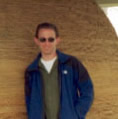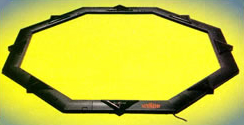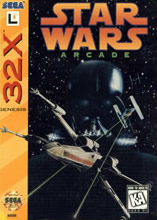Genesis gamers remember many titles fondly. Ask an owner about some of their favorites, and Eternal Champions is bound to come up at some point. Both the original and its Sega CD-only sequel were some of Sega’s best-selling U.S. games, and the company even went so far as to pack the first one with its short-lived Activator peripheral. There’s a lot of controversy behind the creation of Eternal Champions, and Sega-16 has been piecing the story together little by little through our contact with former producers Mike Latham and Scott Berfield.
 Another big game that had its share of controversy was Star Wars Arcade. Those of us who own a 32X have a few games we love as well (believe it, buster!), and in my mind at least, it stands out as an important title. So important was it, that it actually saved Sega’s bacon during the 1995 holiday season in the face of Donkey Kong Country. One thing that’s always stood out in my mind is how the game would have turned out had it been given a full development cycle.
Another big game that had its share of controversy was Star Wars Arcade. Those of us who own a 32X have a few games we love as well (believe it, buster!), and in my mind at least, it stands out as an important title. So important was it, that it actually saved Sega’s bacon during the 1995 holiday season in the face of Donkey Kong Country. One thing that’s always stood out in my mind is how the game would have turned out had it been given a full development cycle.
Recently, I had a chance to speak with someone who was involved in both these games. Steven Lashower was a programmer who got his first big start at Sega with the massive fighter, and during his tenure he worked on a plethora of projects, including a cancelled 32X game called Ratchet & Bolt. A big part of Sega Interactive, he had a lot to say about his time at Sega!
Sega-16: How did you become a part of Sega Interactive?
Steven Lashower: Back in high school, I taught myself 6502 assembly language and started developing Atari 8-bit (400/800/XL/XE) software. One title, a pseudo-3D maze game, was picked up and published by ANALOG Computing in 1986. In college, while working at Disneyland part time, I developed a series of Atari music applications for ANTIC Magazine. In what spare time I had outside of that, I learned 68000 assembly language and was working on a big 128-track MIDI sequencer for the Atari ST.
Some time in spring of 1992 after getting one too many Submarine Voyage shifts at Disneyland, I was on a break and reading thru the job classifieds. Looking back, it is kind of funny that the LA Times job classifieds would be out in a break area at Disneyland, but anyways, I found an ad for a 68000 games programmer. Figuring “What the heck?” I sent in a resume. It turns out the company was a small game studio of about thirty people headed by Rod Nakamoto called Interactive Designs. After about ten minutes of interview questions, he asked me “So, when can you start?” About three months after my start date, Interactive Designs was acquired by Sega and re-Christened Sega Interactive.
Sega-16: With all the publicity and controversy surrounding fighters like Mortal Kombat, how did you feel about the violence in Eternal Champions?
Steven Lashower: Honestly, I never thought that much about it. It may be more correct to say that I never really had time to think about it. The schedule was so tight and the sheer amount of design ideas that Mike Latham generated kept the team working almost around the clock. For the majority of the project, the core members of the team were put up in a hotel down the street.
Sega-16: The Activator gets a pretty bad rap, and it never really seemed to catch on. Why the decision to package Eternal Champions with it?
 Steven Lashower: I thought that the Activator was nothing more than a gimmick. I think the idea behind the Activator was kind of cool, but like the Virtual Boy, and I think it was a little ahead of its time. Tacking the Activator onto the juggernaut that was Eternal Champions was bound to make it a success or at least help it sell more units. From day one, I believed that Mike Latham designed the game to work with the six-button controller.
Steven Lashower: I thought that the Activator was nothing more than a gimmick. I think the idea behind the Activator was kind of cool, but like the Virtual Boy, and I think it was a little ahead of its time. Tacking the Activator onto the juggernaut that was Eternal Champions was bound to make it a success or at least help it sell more units. From day one, I believed that Mike Latham designed the game to work with the six-button controller.
Sega-16: How difficult was it to make Eternal Champions compatible with the Activator?
Steven Lashower: Chris Warner, Sega Interactive’s technical director handled the Activator coding. John Kuwaye and I explained to our in-house producer Mark Nausha that we were “waaaaay too busy” to figure out how the Activator hardware worked. The truth was that neither of us wanted to do it. So, Mark got poor Chris to work on it. Chris is 6’4”+ and his lack of enthusiasm for working on the Activator was quite the funny sight. I think all Chris did was map Activator inputs directly to six-button controller input equivalents.
Sega-16: Eternal Champions went on to become Sega of America’s best selling title. Did its success surprise you?
Steven Lashower: For Mark Nausha, John Kuwaye and I, Eternal Champions was the first big title any of us had worked on. I don’t think any of us had any idea of how big EC was going to be until Mark came in one day with a box of Electronic Gaming Monthly magazines with Eternal Champions taking up the entire front cover. Sega had an amazing marketing department at the time and although Mike Latham is generally credited with the design, don’t discount the work he did in getting marketing motivated about the title. Unfortunately, once marketing got excited about EC, we also had a drop-dead ship date. It would have been nice to have a few more weeks to polish the game a tad more.
Sega-16: Challenge from the Darkside is a fan favorite on the Sega CD and many were saddened at the announcement of part three’s cancellation. Were you slated to work on that sequel as well?
Steven Lashower: Although I got a programming credit, I didn’t really do much work on Darkside. I coded up some AI fixes as well as an ADPCM music driver for the Sega CD that the game was going to use. Since I had left Sega Interactive before Darkside was completed, the idea of using my music driver was shelved. John Kuwaye, Ala Diaz and Tony Ikeda did the coding on the project. Sega Interactive was dissolved shortly after Darkside shipped.
Sega-16: You’ve said that Dinosaurs for Hire was done pretty much on the fly, and that it shipped when your team got tired of working on it. That seems like a pretty big luxury in an industry that makes a habit of shipping games before they’re finished. Was there really that little pressure from Sega?
Steven Lashower: Well, I think that “shipping it when we were tired of it” was an exaggeration on my part. However, the design on the fly part pretty much held true. The original design called for these huge dinosaur enemies. The problem with that: they ate up the majority of the cartridge space and took up quite a bit of screen real-estate, not to mention the game was plagued by “sprite drop out.” One day, Jack Loh brought in a copy of a Japanese shooter for the Genesis called Lunatic Gunstar. After seeing that, the team shared this universal thought: “Boy, were we completely jacked.” We rushed to downsize the enemies to fit more of them on the screen as well as to make them more nimble. I think the only level that pretty much stayed the way it was designed is the level where the dinos smash and stomp all the little toy cars and tanks. A few of the newer enemies were taken right out of Sandy Petersen’s Guide to the Cthulhu Mythos!
Sega-16: Mike Latham supposedly hated the game. What exactly was it about it that he hated?
Steven Lashower: Have you ever played Dinosaurs for Hire? On a positive note, it allowed a few of us to get our teeth wet on the Genesis hardware before moving onto EC. Not toe mention, it allowed Chris Warner to write a new version of our in-house engine (Lobster) that was used in Eternal Champions.
Sega-16: Star Wars Arcade was completed in a scant four months, even adding an exclusive 32X mode. How on earth did you and your team manage to pull off such a solid port in so short a time?
 Steven Lashower: Chris Warner and I did the majority of the coding on the project. John Brandstetter was the producer and kept us provided with pizza, lasagna and soda for the majority of the project. The original game was an arcade machine. Since it was written in 100% assembly language, and the hardware that we were using was vastly different from that of the arcade machine, we figured the quickest approach would be to write a new game from scratch that had the look and feel of the arcade machine. Chris had the Mars development system (about the size of a small fridge), so he worked on the 3D engine. Chris never did any 3D work before, so he had a blank slate to start out with. I coded up the Genesis side of things as well as a new Z80 sound driver. I spent the majority of the project with just only a Genesis development system, pretending that I could see 3D graphics on the screen
Steven Lashower: Chris Warner and I did the majority of the coding on the project. John Brandstetter was the producer and kept us provided with pizza, lasagna and soda for the majority of the project. The original game was an arcade machine. Since it was written in 100% assembly language, and the hardware that we were using was vastly different from that of the arcade machine, we figured the quickest approach would be to write a new game from scratch that had the look and feel of the arcade machine. Chris had the Mars development system (about the size of a small fridge), so he worked on the 3D engine. Chris never did any 3D work before, so he had a blank slate to start out with. I coded up the Genesis side of things as well as a new Z80 sound driver. I spent the majority of the project with just only a Genesis development system, pretending that I could see 3D graphics on the screen
Sega-16: It’s considered to be the game that saved Christmas for Sega in 1995 and one of the best 32X games overall. What did you think of the hardware?
Steven Lashower: Chris and I were really proud of the job we did on Star Wars. It isn’t the greatest game in the world and didn’t get the best reviews, but we did it in four months on hardware that wasn’t finalized until the end of the project! I think Star Wars and the 32X system pretty much sold 1-to-1. My opinion of the hardware? Well, I don’t know game programmer on the planet that didn’t at one time or another think that hardware could ALWAYS be better. As an interesting side note, we got notice about half-way thru the project that as part of a cost-cutting measure, SoA was considering cutting the CPU power of the machine in half. We were very happy when they changed their mind about that!
Sega-16: I’ve heard that it wasn’t necessarily bad to program for, but that most developers moved on because the Saturn was more powerful and already out by the time the 32X was in a position to pick up steam. Did you have any projects that made the jump over to the new console? Any games you would have liked to work on for it?
Steven Lashower: After Star Wars shipped, I became the “32X Guy” at Sega Interactive. Chris Warner moved onto start on Sega Interactive’s Saturn engine. I had the opportunity to work briefly again with Mike Latham on a 32X title called Ratchet and Bolt, a game that really would have turned a lot of heads had it ever seen the light of day. The artwork was stunning and Latham was really targeting this game to be a AAA title. I don’t recall why, but Ratchet was cancelled and I was assigned to work on another 32X title, Xtreme Sports. There was nothing “Xtreme” about that game: the project was so ill-conceived (they were using motion capture software and Alias to render game sprites that were 16-pixels high) that I left Sega Interactive shortly after Mark Nausha’s departure to start work at another company on the Sony PlayStation and Sega Saturn.
Our thanks to Mr. Lashower for the interview!

I love the Dinosaurs For Hire game 🙁